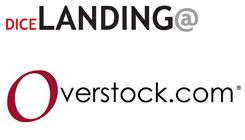What’s it all about? Why the “O” of course, as in Overstock.com. That slogan has propelled the online discount retailer to annual sales of more than $1 billion since its launch in Salt Lake City back in 1999. Numerous awards for Web design, customer service, employee satisfaction and consumers’ progressive passion for online shopping have contributed to the company’s rapid growth.

Last year, headcount reached 1,550 as Overstock hired 300 people, including some 120 developers and testers, according to Brandon Thurman, manager of Recruiting and Retention. The company offers competitive pay and benefits, skill enhancement programs and touts the opportunity to work with smart people. Best of all, Thurman says they’ll make room for anyone with excellent Java skills, a penchant for Agile development and an entrepreneurial spirit. So what’s the catch? Most developers can’t pass Overstock’s coding test. Although Software Architect Sean Landis and Development Manager Mike Singer shared some tips, they admit that Java developers who rely on coding tools often fail the whiteboard exam. Here’s how to navigate the company’s hiring process.
Tailor Your Resume
Your quest for an offer starts with a resume review by Overstock’s hiring team. What are they looking for? Back-end Web development experience, knowledge of Java SE 5.0 and SQL and a strong understanding of object-oriented design and programming. Catch the panel’s attention by highlighting projects that demonstrate your mastery of critical skills. E-commerce experience isn’t required, but security is paramount and so is creating a positive user experience. So, be sure to note your experience with financial tools and penchant for writing secure code.
Ask Salient Questions
Next up, a brief phone interview. Since the best developers crave a dynamic, innovative environment, ask about the inner workings of the development teams and whether the company is open to new ideas and solutions.
Complete the Questionnaire
Resume writing not your forte? You’re in luck. The hiring team sends out a questionnaire probing your experience with SQL, Hibernate and Java. “The questionnaire supplements the information in your resume,” Thurman explains. “It gives professionals who don’t communicate well within the structure of a resume a chance to showcase their development expertise.”
Study for the Coding Test
For these, candidates go to Salt Lake City (on the company), where a panel of architects will ask them to solve a series of coding problems involving Java core class libraries, APIs and object-oriented modeling. The key to success? “Listen carefully and make sure you understand the problem before you start,” Singer says. “Sometimes the requirements in the object modeling question are vague, and we’re willing to give you hints, but you need to tell us if you’re stuck.” “We want the candidate to communicate, to tell us what they’re thinking as they try to solve the problem,” adds Landis. “If there’s a more secure, efficient way to do something, we want to hear it.” The failure rate is high. Landis estimates that some 98 percent of back-end developers struggle with the test because they can’t write streamlined, secure code from scratch.
Ace the Traditional Interview
Finally, hiring managers will delve into your development experience, so be ready to support the claims in your resume by citing specific examples. “We want to see if you can clearly and concisely describe your role in the development process,” Singer says. “Or if your forte is solving memory leaks, I want to know how you did it.” In addition, be prepared: Someone may inject a question like: “How would you change the Java language?” The good news is you won’t be left hanging. According to Thurman, candidates who complete the process learn their fate within 24 to 48 hours.



